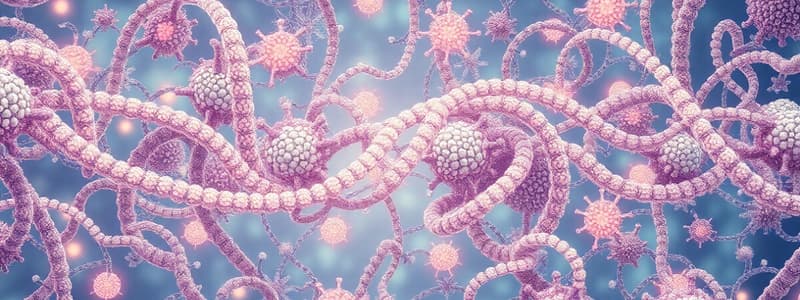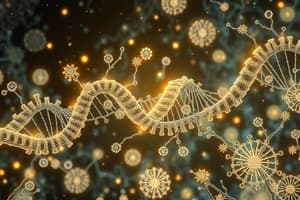Podcast
Questions and Answers
What is the primary function of regulated gene expression compared to constitutive gene expression?
What is the primary function of regulated gene expression compared to constitutive gene expression?
Regulated gene expression responds to molecular signals, allowing for changes in protein levels, while constitutive gene expression maintains constant levels of housekeeping genes.
How does chromatin remodeling influence gene expression?
How does chromatin remodeling influence gene expression?
Chromatin remodeling alters the structure of chromatin, allowing transcription factors to access DNA, which enhances gene expression.
What differentiates inducible genes from repressible genes in the context of gene expression regulation?
What differentiates inducible genes from repressible genes in the context of gene expression regulation?
Inducible genes increase in expression under specific conditions, while repressible genes decrease in expression in response to certain molecular signals.
What role does histone modification play in the regulation of gene expression?
What role does histone modification play in the regulation of gene expression?
What is the significance of DNA methylation at CpG islands in gene regulation?
What is the significance of DNA methylation at CpG islands in gene regulation?
How does DNA hypermethylation affect gene expression?
How does DNA hypermethylation affect gene expression?
What is the impact of gene copy number on gene expression?
What is the impact of gene copy number on gene expression?
Explain why gene amplification is significant in cancer treatment resistance.
Explain why gene amplification is significant in cancer treatment resistance.
What role do mobile DNA elements play in genetic diversity?
What role do mobile DNA elements play in genetic diversity?
Describe the process of DNA rearrangement in immunoglobulin gene production.
Describe the process of DNA rearrangement in immunoglobulin gene production.
Flashcards
Gene Expression Regulation
Gene Expression Regulation
Control of the amount of protein produced from a gene based on transcription and translation.
Constitutive Gene Expression
Constitutive Gene Expression
Constant expression of a gene; always turned on.
Regulated Gene Expression
Regulated Gene Expression
Gene expression that changes in response to signals (e.g., nutrients, stress).
Chromatin Remodeling
Chromatin Remodeling
Signup and view all the flashcards
Euchromatin
Euchromatin
Signup and view all the flashcards
Gene amplification
Gene amplification
Signup and view all the flashcards
Gene deletion
Gene deletion
Signup and view all the flashcards
DNA rearrangement
DNA rearrangement
Signup and view all the flashcards
Transposons (Tn)
Transposons (Tn)
Signup and view all the flashcards
Gene copy number variation
Gene copy number variation
Signup and view all the flashcards
Study Notes
Regulation of Gene Expression
- Gene expression is the control of protein production from DNA.
- Constitutive genes are expressed constantly to maintain cellular functions.
- Regulated genes adjust their expression based on cellular needs.
- Inducible genes increase expression under specific conditions.
- Repressible genes decrease expression under specific conditions.
Regulation Levels
- Chromatin remodeling: Changes in chromatin structure, like acetylation and phosphorylation of histones, affect gene accessibility to the transcriptional machinery.
- Gene copy number: Increases or decreases in gene copies can alter protein production.
- DNA rearrangement: Rearrangement of DNA segments (e.g., in immunoglobulin genes) leads to diverse protein products.
- Methylation: Addition of methyl groups to DNA can repress gene expression.
- Alternative splicing and polyadenylation: Different mRNA versions can be generated from a single gene.
Transcriptional regulation
- Basal expression elements: Core promoter sequences essential for transcription initiation.
- Regulated expression elements: Cis-acting elements (e.g., enhancers, silencers) that control gene expression.
- Transcription factors: Regulatory proteins that bind to DNA to either activate or repress transcription.
Post-transcriptional regulation
- RNA editing: Changes to mRNA nucleotide sequences.
- mRNA stability: mRNA lifespan influences protein production.
- Alternative splicing: Different mRNA versions from a single gene.
- Translation regulation: Control of protein synthesis at the translational level.
- Post-translational regulation: Modifications of proteins after synthesis influence their activity and duration.
Clinical Implications
- Gene regulation is targeted by many drugs for disease treatment.
- Drugs can affect gene expression via nuclear receptors or downstream signaling pathways.
Studying That Suits You
Use AI to generate personalized quizzes and flashcards to suit your learning preferences.




